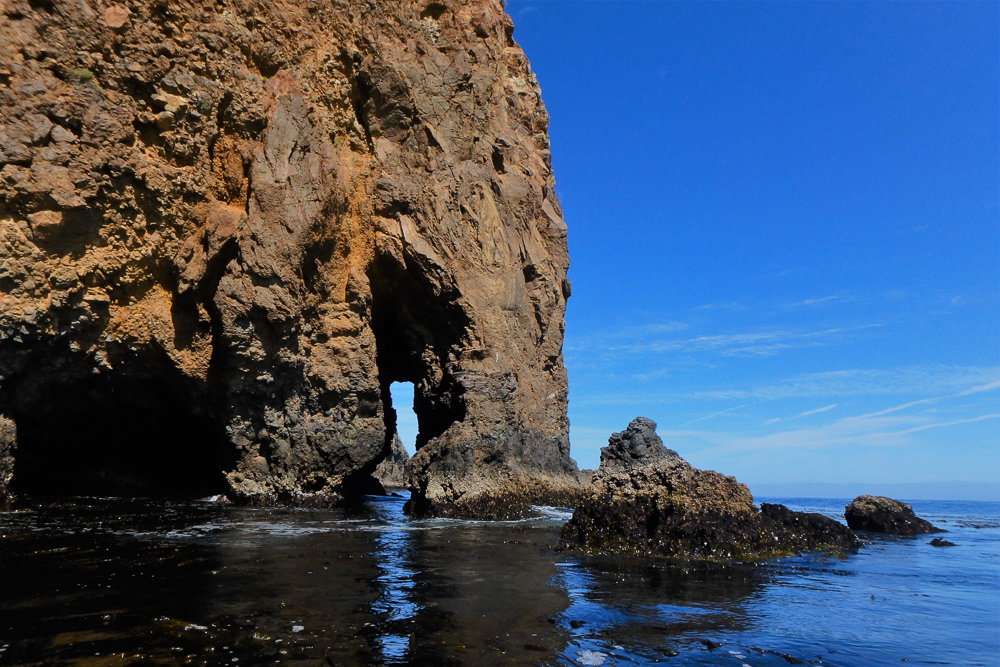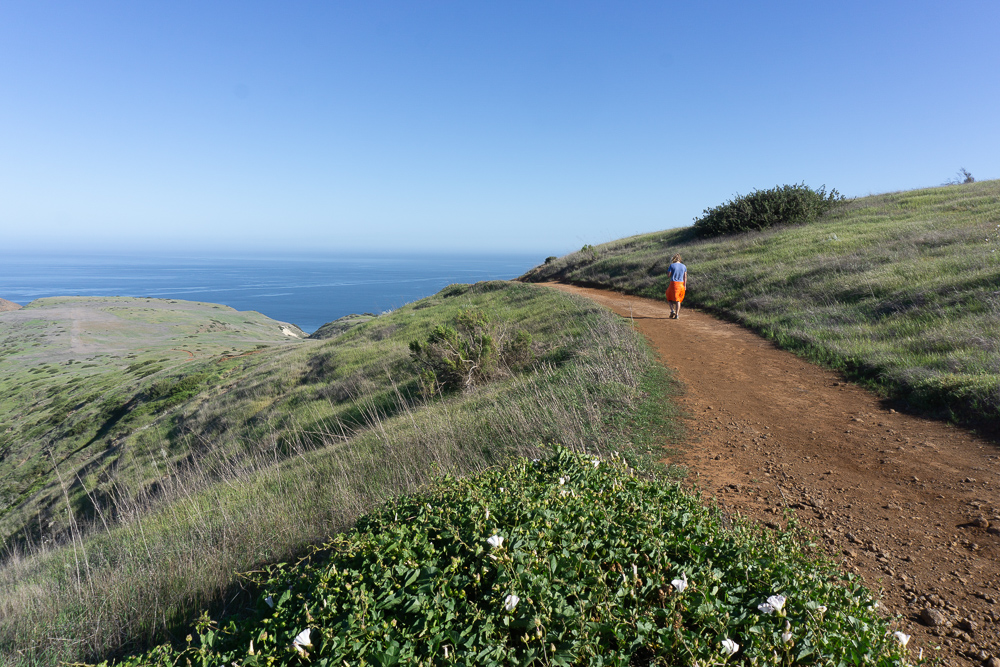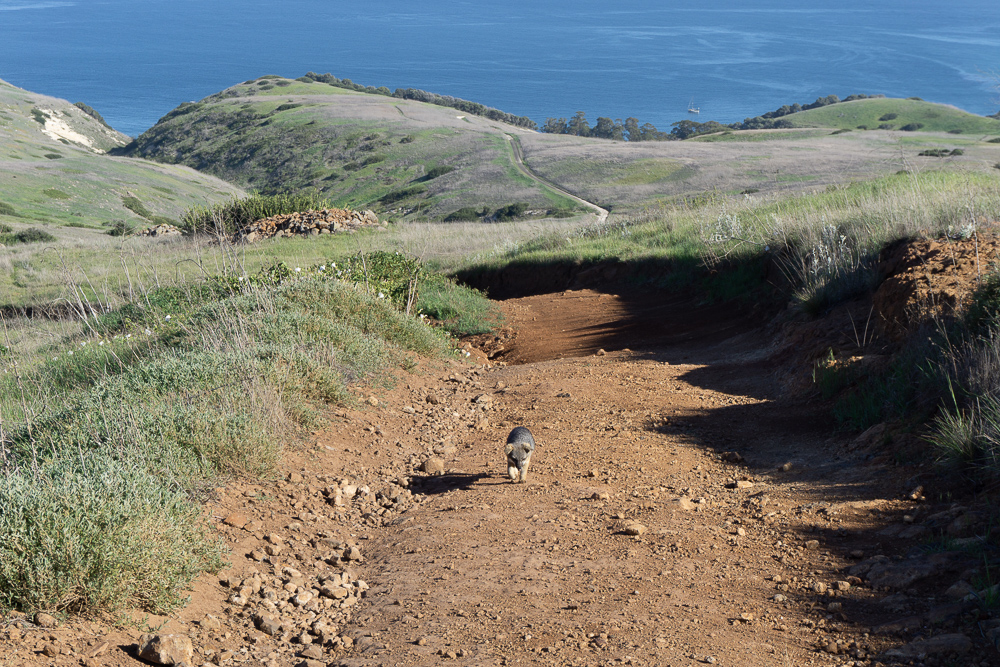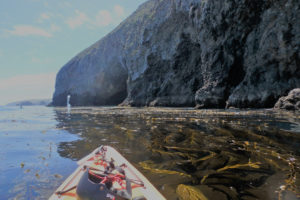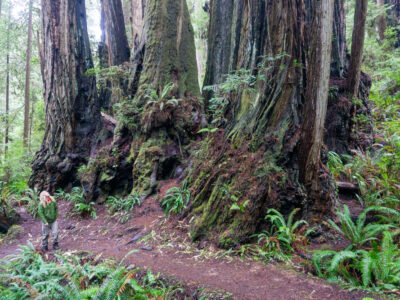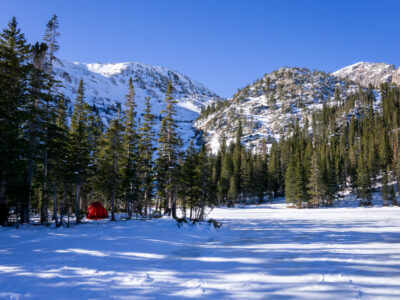08 Apr Kayak Santa Cruz Island, Channel Islands National Park
guides // backpacking // southern california
Kayak: Santa Cruz Island, Channel Islands National Park, California
Channel Islands National Park is a place that always intimidated me when we lived in California. We knew we wanted to go to all eight National Parks in the state, but I just couldn’t get my act together for this park. Every time I would start planning a trip here, I would back out because of the price (it’s a tad high) or the time commitment (you’ll need more than two days). It also didn’t help that we wanted to go ocean kayaking independently, without a group tour, which was actually pretty hard to figure out because there wasn’t a lot of information about how to do it. That’s why I’ve made this guide almost insufferably detailed – I expect people to skip giant chunks of it, but when you want to start planning a trip here, you know where to find all the information.
There’s a whole lot of stuff to do on these islands. We chose to go to Santa Cruz Island for the kayaking and unique island foxes, but there’s plenty to do on all the islands and they’re all beautiful. There’s even a couple backpacking opportunities if you want to be on-brand and stick to the backpacking. We chose to focus on sea kayaking, which was totally new and horrifying to me, but we also went on a long day-hike across the island and snorkeled in one of the coves (also new, also horrifying). One of the best things about the islands is how easy it is to see wildlife. We saw A LOT of island foxes super up close, a majestic 1000+ pod of surfing dolphins, and enormous pelicans that could probably eat me in one bite. It was like being in a zoo, but without any of the glass and the cages – and any of the other famously dangerous carnivorous zoo animals.
Quick Notes
Photos taken April 2018
Days: 2+ Nights
Difficulty: Hard
Boat Launch: Ventura Harbor (1691 Spinnaker Drive #105B, Ventura, CA)
Seasons: All
Reservations Required: Yes
Camping: Scorpion Campground or Del Notre Backcountry Campground
Map: National Geographic Channel Islands National Park
Water: Drinking water available at campgrounds
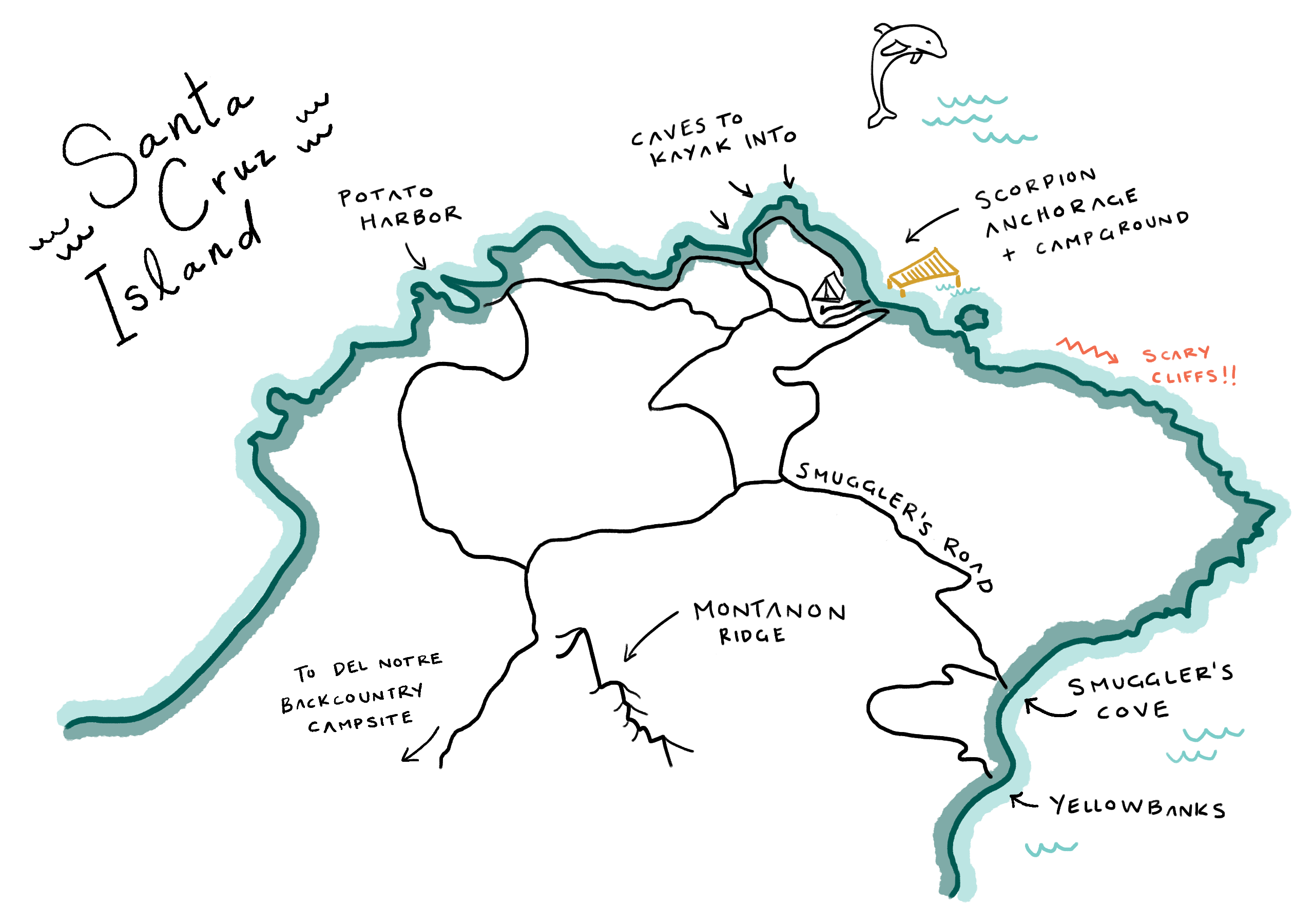
When to Go
Deciding when to go is all about what kinds of animals you want to see. And the list of animals is extensive: foxes, all kinds of seals, whales, dolphins, otters, pelicans, and a long list of other coastal and land birds. The weather is very mild (much like the rest of Southern California) and doesn’t change much with the seasons. The ocean is always cold here, so you’ll probably need a wet suit to kayak or snorkel, no matter when you visit.
The National Park Service has a great web page describing what kinds of conditions you can expect for every season and when animals are most active. We went during late spring to see the island foxes pupping and to avoid peak-season crowds in June through August.
Trip Cost
Park Entrance Fee*
Campsite
Boat Transportation
Kayak Rental
$35
$15/night
$79/person + $15/kayak
$55/day for a double & $35/day for a single
*If you know that you’re going to be going to a national park more than three times in a year, it’s worth it to buy a National Parks Pass. They’re $80 and sold online, at all REI locations, and National Park Visitor Centers.
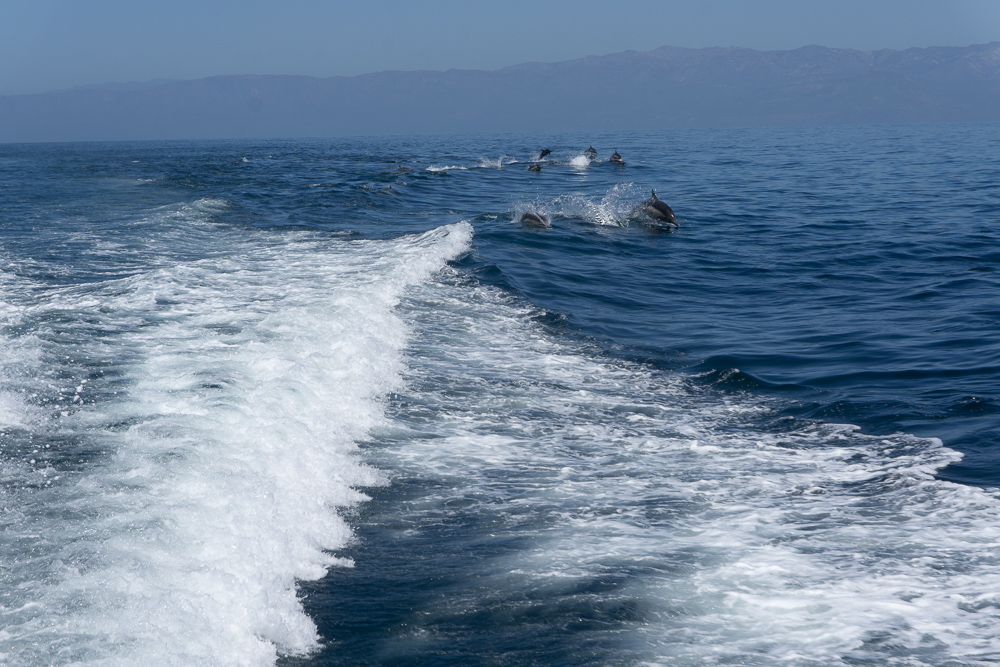
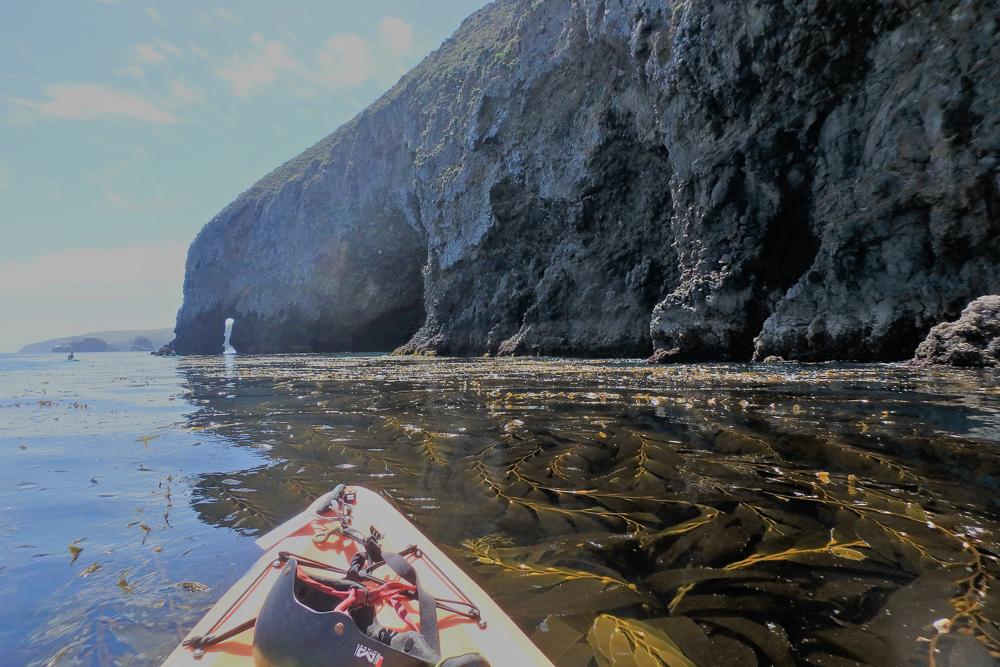
Before You Go
There are a ton of moving parts to the trip, so this section’s going to be a long one – grab a cup of coffee and settle in (please).
The first step to planning a trip to Channel Islands is deciding which island to go to. There are five islands to pick from – Anacapa, Santa Cruz, Santa Barbara, San Miguel, and Santa Rosa. We picked Santa Cruz because it’s the easiest island to get to, has calm ocean conditions for sea kayaking, and we’d have the best chances of seeing the island foxes here (have I mentioned I wanted to see the foxes yet – because I really wanted to see the foxes). It’s also the biggest island of the five, so we knew we wouldn’t run out of hiking trails. One drawback of Santa Cruz Island is that half of it belongs to the Nature Conservancy which doesn’t allow recreation within its borders or coastal areas; however, the island is so big that we didn’t have any problems avoiding their land. For more information on the other islands, visit this page on the park’s website.
Camping
Once you decide which island to go to, you have to choose and reserve your campsite. Most islands only have one campsite to choose from, but Santa Cruz has two – there’s the Scorpion Ranch Campground (31 sites) and the Del Notre backcountry campground (4 sites). Ordinarily we would choose the Del Notre backcountry site for its remoteness (the hike in is 7 miles), but it turns out that it’s really hard to launch a kayak from that area. Since kayaking was non-negotiable, we settled on the Scorpion Ranch Campground, which has a nearby cove that is perfect for launching our kayak. If you don’t plan on doing ocean activities, the Del Notre campground looks like a great place to spend a couple days.
Both campsites on Santa Cruz fill up very quickly, so the best way to get a spot is to make a reservation super early at Recreation.gov. If you can reserve a hotel room, you can follow the reservation process on this website – pick your dates and the number of people, pick your campground, and cross your fingers that there’s availability on your selected dates. Reservations can be made up to 6 months in advance. For reference, I made the campground reservation a little more than 5 months in advance and from what I remember, we got one of the last spots.
Transportation
The next step in this logistics saga is to arrange your transportation to the island. Most people take a boat, but if you happen to be super rich, you can take the scenic route in a helicopter. The only commercial boat company that goes to the Channel Islands is called Island Packers. Tickets are $79 per person and kayaks are an additional $15. If you’re staying overnight, the Island Packers reservation system will ask you for the confirmation number of your campsite reservation. This is why you have to make camping reservation before you go – no spur of the moment stuff here. Boat reservations are a bit less difficult to get compared to campsite reservation. I made ours 4 months in advance.
Island Packers has a bunch of regulations for how much cargo you can bring onboard, but as backpackers, you probably won’t be travelling with a lot anyways. This trip does give you a good opportunity to bring a cooler full of real-people food and drinks though. While packing, keep in mind that Island Packers requires you take propane and water out of your backpack before putting backpacks in the cargo hold of the boat. The propane tanks go in a box with everyone else’s fuel, so make sure you label your propane because all propane tanks essentially look the same. We had a little emergency where we “lost” our propane tanks (thieves took them), and we had to borrow propane from the ~extremely~ nice park rangers. Your water will go in an area on the front deck of the ship with everyone else’s water. If you’re staying at Scorpion Campground, you don’t need to bring a lot of drinking water though because there’s potable water at the site.
If you’re planning on renting a kayak or bringing your own, you have to call Island Packers to add a kayak onto your reservation. They have limited space for kayaks, so do this right after you arrange the ride. For some reason, there’s no way to add a kayak on the online reservation system. You have to pick up a phone and interact with a real human at Island Packers.
On the day of the trip, you don’t need to know how to hook your kayak up to the boat or any other complicated boat things. You just walk your kayak to the dock and the deck hands will take care of everything else.
Kayak Rental
The final step is to rent your kayak, and the best way to do that is through the Channel Islands Kayaking Center, because they’re located in the same building as Island Packers. It costs $55 a day for a double kayak and $35 for a single. The kayak also comes with paddles, helmets, and life jackets. The Kayaking Center also has guided tours for people who want to try kayaking, but maybe want a little more guidance. From what we noticed, most people who kayaked went with a tour group. On the island, we must have been two of only eight to ten people that kayaked without a group.
Channel Islands Kayaking Center has two location – and this gets confusing. Their primary location is called the Channel Islands Harbor Location, but this IS NOT where you’ll be picking up your kayak – DON’T GO HERE. You’ll be picking up your kayak at the Ventura Harbor Location, but you have to call the primary location to book a kayak at the secondary location. My guess is that they don’t station someone at Ventura Harbor if no one calls for a kayak that day. I sort of forgot this step, and called them the day before – luckily, there were no problems with that, but I’d recommend calling a couple days in advance.
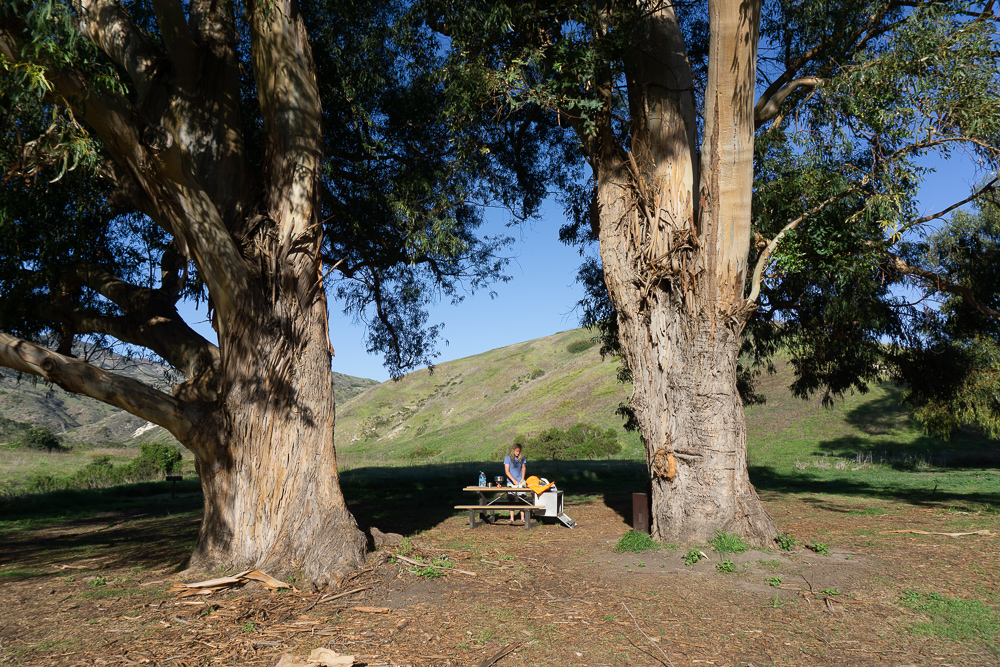
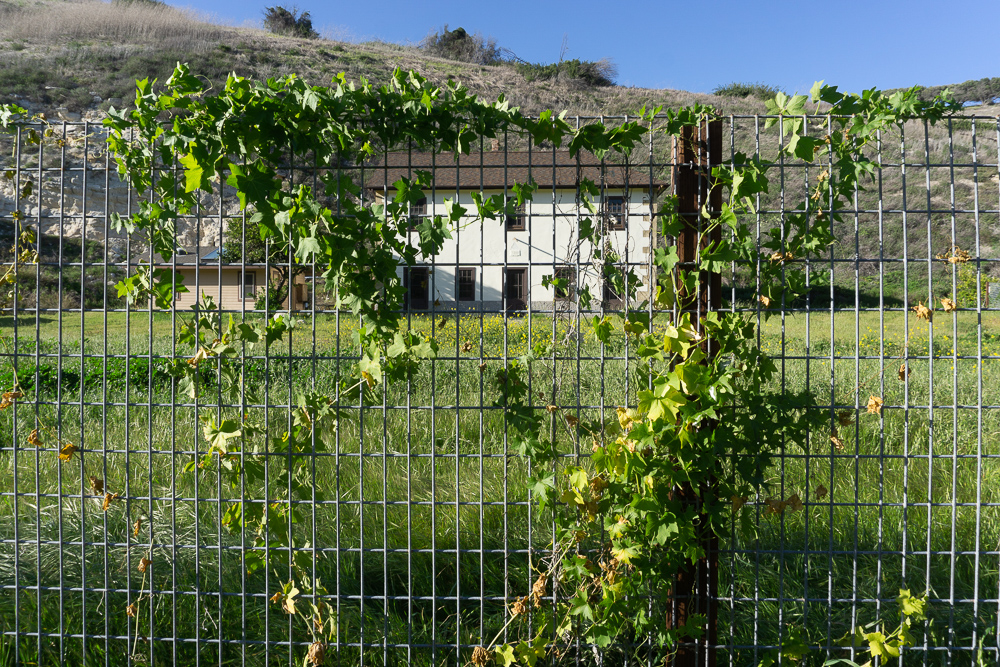
Getting There
Island Packers wants you to arrive at Ventura Harbor an hour before your departure time. Getting to Ventura Harbor is fairly simple but figuring out the parking situation is a different story. Overnight parking is only allowed in the Whale and Turtle lots. Google Maps and other map apps recognizes “Island Packers Cruises” as the exact location of the office and dock.
Once you get to the harbor and legally park your car, you go to the office and let them know you’re here. They’ll also give you a parking tag for your car so you don’t get towed. After that, you check-in with Channel Islands Kayaking Center for your kayak rental. They’ll take you through all the safety rules, give you some kayaking tips, and show you the best (and safest) places to kayak.
Finally, you walk your kayak to the boat, drop propane off in the designated box, and depending on when you got there, stand around and wait for departure. The deck hands will call out when to bring your cargo to the boat and when to board. This process may sound simple, but in reality, you’ll find yourself in a cluster of disorganized people until you happily make it onto the boat.
The boat goes very fast so you may want to bring some sea sickness medicine if you know that’s a problem for you. I took some Dramamine and I still got sick on the way there. I still get nauseous when I smell that yellow Neutrogena sunscreen, because I put some on before getting on the boat and now the two things are linked together forever. On the way back, we sat at inside the boat rather than on the top deck outside, and I didn’t get sick at all. Dylan still got a little sick, but I guess it’s worth a try.
On the Island
Kayaking
To me, the main attraction of Channel Islands is the ocean kayaking. Where else can you explore sea caves and marine life so easily? From Scorpion Anchorage you can explore either direction of coastline, but the rangers recommend exploring the right side only when the tide is super calm, because there’s a chance you could get swept into a rough area and need emergency rescue (which happens to cost a lot of money).
Sea kayaking is all about judging the waves and knowing which direction the tide is moving. The tide at Scorpion Anchorage moves north to south, which means that if you’re standing on the beach, the tide will be moving left to right. That’s why it’s safest to explore the coast line to the left of Scorpion Anchorage – you’ll be paddling against the tide first (when you’re at peak-paddle-power) and then when you want to paddle back, you just rotate the kayak and let the tide bring you back home. When you pick up the kayak at the rental place, they’ll explain all of this in more detail.
Ocean kayaking at Santa Cruz is a “choose-you-own-adventure” type of activity. You can have a peaceful kayaking time and only take the kayak out in the morning when the tide is calmest, or you can turn kayaking into an extreme sport and go out during rougher tides in the afternoon. If you prefer the more peaceful route, you can also kayak slightly farther away from the coast where the ocean waves interact less with the land and are much smoother.
In the two days we kayaked, we got to know the left side of coast line pretty well. We were able to go out in the kayak three separate times and spent two hours out on the water each time. I had grand plans of bringing a picnic with us and setting up on one of the tiny beaches along the way, but the waves were way too rough to make it happen. It was my first time ocean kayaking so I had a bit of work to do when it came to learning how to steer the kayak and the best way to manage the bigger waves. I don’t handle the ocean particularly well, so I really didn’t want to go anywhere near the rocky coast line at first. However, after some practice and a couple pep-talks from Dylan, we ended up getting a lot closer to the coast and we even went inside two sea caves during low tide.
We did, however, have an ordeal where we got overconfident, misjudged the ocean, and ended up flipping the kayak uncomfortably close to the rocky coastline. Nature has a really great way of humbling you. As much as I’d love to look like a nature superstar, sometimes we get ourselves into some pretty scary situations. So – there’s a narrow arch-way on the left side of Scorpion Anchorage that is just wide enough for a kayak to pass through (see the cover photo of this post). We saw a tour group going through it so we tried it out as well. The first time was a success – it was fun and we circled back around one more time. The next day, the tide was a lot rougher (we went out there in the afternoon) but for some reason we went for the arch anyways. The trick is to wait for a calm period in the tides and then pass through. We ended up getting stuck midway through the arch and got the full force of a wave behind us. The ocean pushed our kayak forward into the rocky face, and we instinctively reached out towards the rock wall to brace ourselves. All that action caused the kayak to flip, and out of the kayak we went – along with all of our stuff. I went into a state of shock, basically turned into a dolphin, and hurled myself back on the kayak faster than I’ve ever moved. Dylan was a lot calmer and managed to grab most of our stuff that spilled out of the kayak.
It still puzzles me how we didn’t get more hurt that day. We were both a bit scratched up, but otherwise, we didn’t have any real injuries. Now, every time we debate about whether or not to do something risky, I think back to this day and how nature can turn on you at the most inconvenient (and dangerous) times.
Our ~mishap~ aside, trying ocean kayaking was a great experience and I would 100% do it again. There are so many pockets of coast line that you can only get to by boat, including this one, and this trip left me with excitement for future kayaking trips.
If you want to try sea kayaking but aren’t ready to go at it solo, there are two local companies that do tours of the islands. The Channel Island Kayaking Center and the Santa Barbara Adventure Company have public and private kayaking tours of the islands. Additionally, there’s a world famous cave on the Nature Conservancy side called the Painted Cave that can only be accessed by taking a tour with the Santa Barbara Adventure Company.
Snorkeling
If you want to do some ocean exploring, but don’t want to go straight into sea kayaking, you can snorkel right off the beach at Scorpion Anchorage. The beach is a great place to try out snorkeling for the first time because the water is calm and there’s a lot to see down there.
If you’re kayaking, you can go snorkeling in more remote locations by docking at some of the sheltered coves along the coast. Be careful with the rocky sections though, because the tides can get rough. When we went, the ocean was a bit too rough to dock the kayak, so we took turns snorkeling farther away from the rocky coves. One of us would stay in the kayak and control its whereabouts, while the other would play in the water – or at least that was the intent. I, being a horrible swimmer and never having snorkeled, basically flailed in the ocean until I was too cold to stay any longer. I did see some cool kelp though. Dylan had a much more organized snorkeling experience, as you can see in the photo.
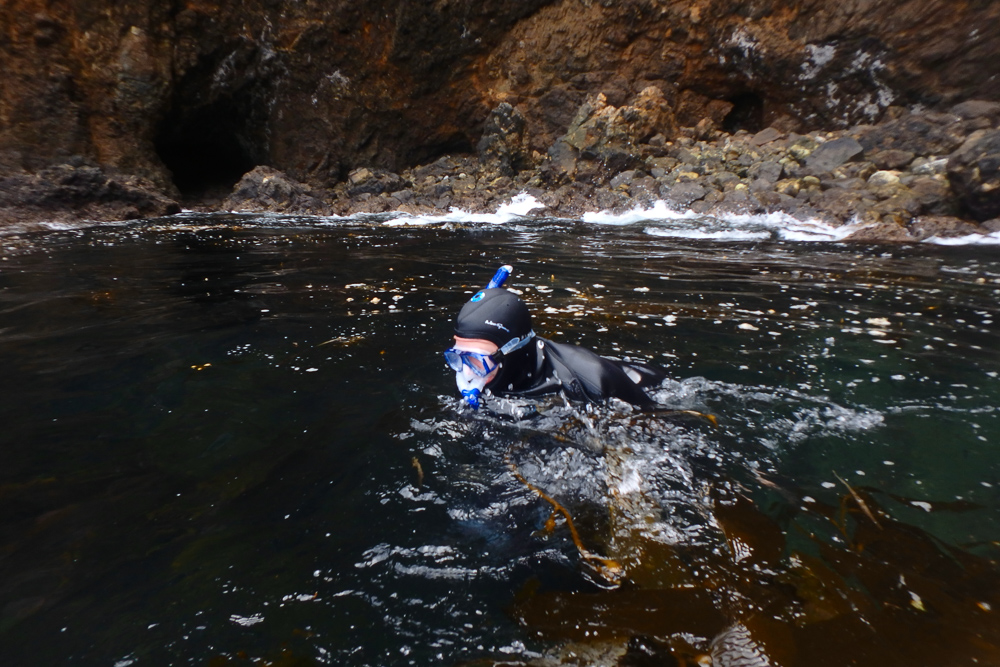
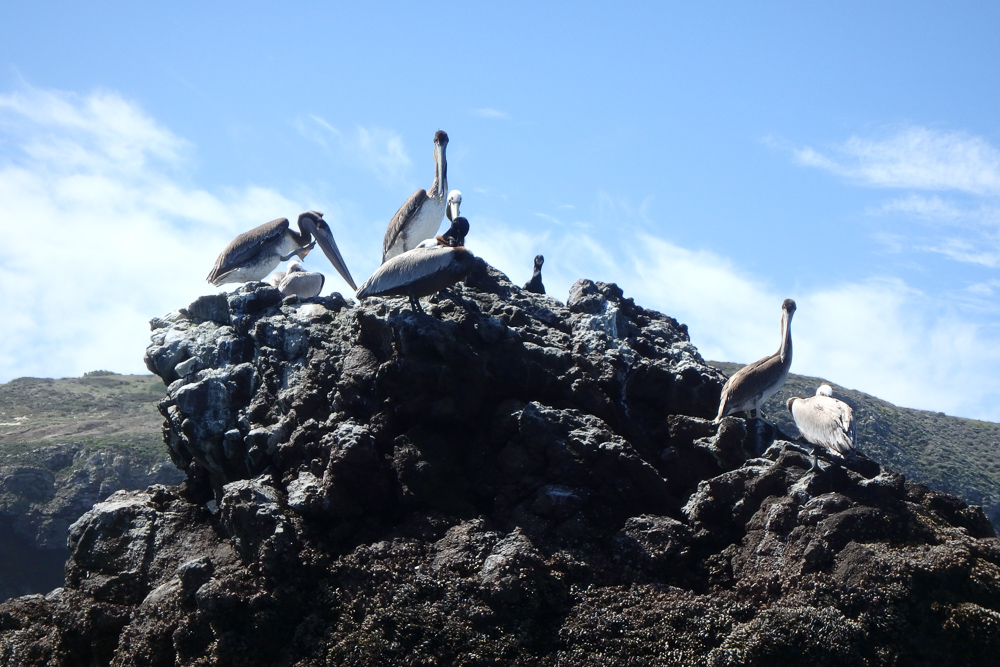
Hiking
Even though a lot of the activities on Channel Islands are focused around the ocean, there’s still a lot to do on dry land. There’s a large network of hiking trails that start at Scorpion Campground and continue up and over the mountains to several beaches on the other side of the island. The way the afternoon sunlight hits the rolling hill side could be its own attraction on the island – the California sun loves these mountains. Our favorite hike was an 8 mile round-trip to Smugglers Cove on Smugglers Road (it’s an old dirt road that nature has reclaimed). We even saw two adorable island foxes along the way (again with the island foxes).
There’s also a couple short trails from Scorpion Anchorage that take you along the jagged coastline, where you can watch kayakers like us try our best in the ocean. It’s also an excellent vantage point for bird watching and the scenery is beautiful. For a quick hike from the campground, try out the Cavern Point Loop Trail.
Backpacking
As mentioned, there’s also backpacking on Santa Cruz Island. If you get off at the secondary Prisoners Harbor drop off point on Santa Cruz Island, it’s a 7 mile uphill hike to the Del Notre Backcountry Campground. The campground is perched on top of a hill and has distant ocean views. From the pictures I’ve seen on the Internet, the sunsets here are majestic. There’s also a bunch of hiking trails radiating out from the campground.
After the Voyage
Hands-down, the best restaurant in Ventura has to be Spencer Mackenzie’s seafood restaurant/shack. Their specialties are fish tacos and burritos, and they have an outdoor sitting area perfect for relaxing after a trip. They even have super healthy options like a spicy shrimp and grilled veggie plate. We actually went there twice – the night before our trip and the day after our trip because the food was so good. We’re so obsessed with their fish tacos that we regularly try to replicate them at home in Colorado. Bonus tip: their wontons are WORTH IT.
I also have to mention how perfect Ventura is. It’s got California surf culture, with a cozy downtown, lots of fresh seafood options and way more breweries than expected for small costal town. The whole vibe of Ventura is happy, and it’s definitely worth arriving a bit earlier or staying a bit later to explore the town.
Supply List
The Usual List
Backpack
Tent
Sleeping Bag
Sleeping Pad
Sleeping Bag Liner
Camp Stove
Lighter or Matches
Cooking Pot
Food
Water Vessel
Water Filter
Headlamp
Clothing
Trip Specific Things
These special items focus on being in the ocean. If you don’t plan on kayaking, swimming, or snorkeling, you can ignore this stuff.
Waterproof Backpack
If you want to bring anything with you while you’re kayaking, it’s important to have your stuff a waterproof backpack in case of mishaps. We got ours from Amazon for $30 and it’s just a thick plastic sack with some backpack straps. It survived our kayak flip and kept all of our stuff dry.
Wetsuit + Bathing Suit
If you want to go in the ocean at all, you’ll need a wetsuit. I bought a wetsuit from Ripcurl in Ventura the night before our trip. Dylan on the other hand, proclaimed he was a merperson and refused to buy a wetsuit – of course the ice-cold Pacific Ocean won that battle and he ended up renting a wetsuit for $20 from the tiny rental shop on Santa Cruz Island. The Channel Islands National Park website says there are no provisions on the island but this place was open when we were there. No word on whether it’s always open; we just got lucky.
Snorkeling Gear
Just another fun activity on this island paradise. You can bring your own snorkel stuff or rent it from the tiny shop on the island
Thinking about doing this trip? Have any questions? Comment down below!

